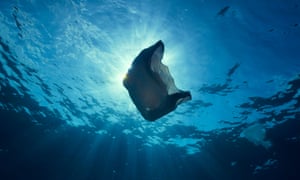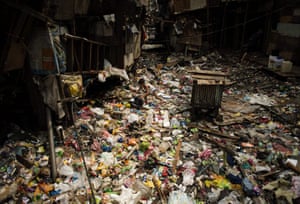
West Wales, last weekend. The old foam mattress lying waterlogged on an otherwise clean beach might have been at sea for months before it was washed up on the tide. A large bit of it had broken off, and the rest was crumbling. It was a clear threat to wildlife, so we heaved what was left of it above the wave line and promised to come back to dispose of it properly when it was dry.
But how do you safely dispose of an old mattress made of billions of tiny plastic particles leaking formaldehyde and other potentially dangerous chemicals? Do you burn it? Bury it? Do you expect the company who made it to come to collect it? Answers to environment secretary Michael Gove, who today pledged to stem the tide of plastic debris by announcing a consultation on a plastic-bottle return scheme for England, which aims to get people to recycle more.
Gove’s initiative is welcome, but minimal, and will have zero impact on the vast and growing scale of the plastic problem. The scheme is aimed at people fed up with litter, and to Blue Planet viewers who are shocked by images of birds swallowing plastic straws and turtles being choked by plastic bags. It is no more use than a heavy smoker forgoing a single cigarette.
Since we started engineering polymers to make plastic on a mass scale in the 1950s, this byproduct of the petrochemical industry, which uses about 6% of all the oil we extract a year, has spread to myriad manufacturing processes. Plastic is now ubiquitous, insidious and impossible to avoid. It makes up our clothes, containers, bottles, electronics, food trays, cups and paints. Our cars depend on it, so do our computers, roofs and drain pipes. It’s the global packaging material of choice. We sleep on it, wear it, watch it, and are in direct bodily contact with it in one form or other all day and night.

It may have profound societal benefits, but this most successful of all manmade materials sticks around for centuries. When exposed to sunlight, oxygen or the action of waves, it doesn’t biodegrade but simply fragments into smaller and smaller bits, until microscopic or nano-sized particles enter the food chain, the air, the soil and the water we drink.
The BBC’s hugely popular Blue Planet series and a stream of scientific studies have made us aware of how the oceans are being polluted, but we still have little understanding of how human health is impacted by the many synthetic chemicals and additives that are used to give plastic its qualities. In the past few years, minute microplastics and fibres, measuring the width of a human hair or far less, have been found in an extraordinary range of products, such as honey and sugar, shellfish, bottled and tap water, beer, processed foods, table salt and soft drinks.
In one study, 95% of all adults tested in the US had known carcinogenic chemical bisphenol A in their urine. In another, 83% of samples of tap water tested in seven countries were found to contain plastic microfibres. A study published last week revealed plastics contamination in more than 90% of bottled-water samples, which were from 11 different brands. And earlier this year the River Tame in Manchester was found to have 517,000 particles of plastic per cubic metre of sediment – that’s nearly double the highest concentration ever measured across the world.
The more researchers look, the more they find in the human body. The same scientists who raised the alarm on air pollution from the deadly particles emitted by diesel vehicles are now finding plastic microparticles raining down on cities, and blown into the air from cars and construction sites, washing lines and food packaging. Indoor plastic pollution may be even worse than outdoors, with a single wash of sports kit or manmade textiles found to release thousands of microfibres into the air.
At a recent UK workshop convened by the marine group Common Seas, 30 scientists, doctors and others compared notes, and agreed unanimously that plastic is now in what we eat, drink and breathe, and constitutes a significant and growing threat to human health.
If we can breathe in these micro- and nano-sized particles and fibres, the scientists conjecture, they are likely to get into the human bloodstream, lung tissue and breast milk, or become lodged in the gut and respiratory systems. Some microparticles may pass through the body without causing harm, others may lodge there dangerously. Many are suspected to be carcinogenic or to have hormone-disrupting properties.
The consensus is that there are great gaps in what we know about how microplastics affect human health, and that we need more robust science. We don’t know the risk when we drink contaminated bottled or tap water every day. We don’t know how much we are ingesting or breathing, or what effect exposure to hazardous plastic particles may have over years. We don’t know the concentrations that are safe for adults, let alone infants. There is mounting concern that under-studied microplastic particles threaten health by presenting a potentially major source of toxic chemicals to the human body.
Although we have known for years that some of the additives used to make plastics flexible, transparent or durable are chemically dangerous, few have been tested on humans. Some countries have banned some chemicals – but there is no consistency, and the chemical companies have found it easy to avoid regulation, finding substitutes that are potentially just as dangerous.
It is not enough to single out plastic bottles, coffee cups, or the microbeads found in cosmetics. We urgently need the government to form a comprehensive plastic action plan. Banning all plastic bags and single-use packaging would be a good start, but we need to go way beyond that. Plastic production has to be reduced, just as alternatives should be encouraged. Regulators must think about phasing out whole groups of chemicals of concern, rather than slowly restricting individual chemicals one at a time, and consumers must be helped to understand what they are being exposed to, and to navigate the complexity of what can be recycled, composted or burned.
In the 1950s the world made about 2m tonnes of plastic a year. Now that figure is 330m tonnes a year – and it is set to treble again by 2050. It’s not enough to return a few plastic bottles, or even to pick up an old mattress on a beach.

